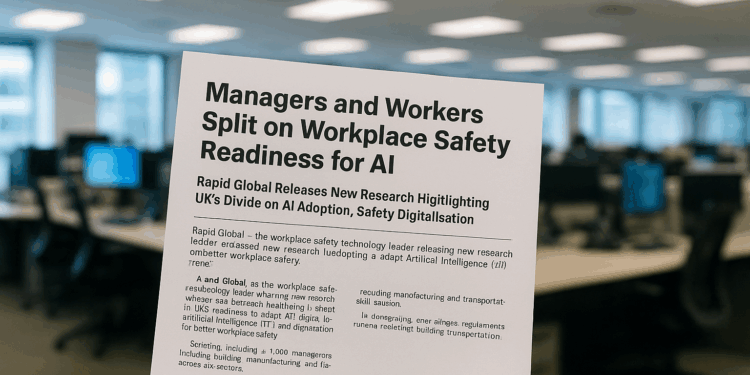Story Highlight
– 36% of managers believe AI reduces safety risks; 16% of workers.
– 47% of managers think their businesses are ready for AI.
– 68% of managers support unified safety systems; 24% of workers disagree.
– 33% of workers seek more education on AI’s benefits.
– 22% of workers find safety processes anxiety-inducing, especially younger women.
Full Story
A new report by Rapid Global reveals significant disparities between the opinions of managers and frontline workers regarding the integration of artificial intelligence (AI) and digital technologies in workplace safety within the UK. The research highlights contrasting perspectives and readiness for technological adoption among over 1,000 participants from various sectors, including construction, facilities management, manufacturing, logistics, warehousing, property management, and transport.
The findings indicate that more than a third of managers, specifically 36%, are optimistic about AI’s potential to mitigate safety risks. In stark contrast, only 16% of frontline workers share this belief. Furthermore, while nearly half of the managers (47%) assert that their organisations are well-prepared to implement AI in safety protocols, merely 16% of workers concur with this assessment. The divide extends to the current use of AI technologies, with 32% of managers claiming that such systems are already operational in their workplaces; however, only 8% of frontline workers can identify any evidence of AI in their daily tasks.
Additionally, the disconnect is evident in attitudes towards a unified safety management system. A significant 68% of managers agree that such an integrated approach would facilitate regulatory compliance. Conversely, nearly 24% of workers indicate that their organisations still rely heavily on traditional paper-based processes for essential activities ranging from onboarding to incident reporting. Furthermore, 29% of workers confessed that entrenched habits are hampering the adoption of new technological solutions in their work environments.
Concerns surrounding AI comprehension also emerged, with 33% of workers expressing a desire for enhanced training on how AI can enhance safety practices. Moreover, 24% admitted they do not fully grasp the role AI plays in workplace safety.
The Rapid Global UK Workplace Safety Report also uncovered other revealing statistics: 30% of managers acknowledged hastening safety training while only 12% of workers reported similar experiences. A notable 42% of managers wish to streamline safety systems, yet 19% of workers, along with 15% of managers, still depend on outdated paper processes for reporting incidents. When it comes to timely reporting of safety issues, 38% of managers find this a challenge, as opposed to 24% of workers. Anxiety related to safety processes resonates with 22% of workers, with the figure notably higher among younger employees; 37% of those aged 25-34 experience anxiety, compared to 19% of those over 55.
The research, executed by Research Without Barriers in August 2025, clearly illustrates an existing rift within UK workplaces regarding safety management and the readiness to embrace AI solutions. This gap may be influenced by miscommunication about the types of technologies under discussion. In the realm of workplace safety, the focus appears to be shifting from generative AI to more established technologies like computer vision, facial recognition, and machine learning, which have demonstrated tangible improvements in compliance and risk management.
Paul Rapuano, Global Strategic Partnerships Manager at Rapid Global, emphasized the need for educational investment to bridge this perceptual gap. He stated, “The Rapid Global UK Workplace Safety 2025 Report shows that while managers increasingly see automation and AI as vital to reducing workplace risk, strengthening compliance, and driving efficiency, frontline workers remain cautious.” He added, “The opportunity for businesses to get measurable value from practical AI like Computer Vision is very real, but success depends on investing in education so that technology adoption treats workers like active partners.”
Dr Andrew Sharman, a prominent safety expert and CEO of the International Institute for Leadership and Safety Culture, commented on the implications of the findings. He noted, “This important research by Rapid Global reminds us that real safety transformation in industrial workplaces isn’t achieved simply through digitalisation, though that’s essential, but by deepening trust, connection and engagement.” He expressed that while technology serves as a tool, it should not overshadow the importance of human interaction. “The future of safety leadership won’t be measured by how quickly we install systems, but by how effectively we humanise technology to create workplaces where people feel seen, valued and safe.”
Moving forward, Rapid Global advocates for a workplace safety action plan that prioritises education and pilot projects. Such initiatives can demonstrate the clear benefits of integrated digital safety systems for everyone, including workers, contractors, and the broader organisational framework. Rapuano concluded, “Businesses that act now to embrace AI-enabled, unified safety platforms will cut risk, protect their people, and strengthen resilience, but only if they bring workers with them.”
Key Takeaways
– 36% of managers vs. 16% of workers believe AI will reduce safety risks.
– 47% of managers feel ready to adopt AI, but only 16% of workers agree.
– 32% of managers report AI usage, compared to 8% of frontline staff.
– 68% of managers think a unified safety system eases compliance; 24% of workers still rely on paper processes.
– 33% of workers want more education on AI’s safety benefits.
– 30% of managers fast-track safety training; only 12% of workers do.
– A significant trust gap exists between management and frontline workers regarding technology adoption.























This gap in perception is a real barrier to effective implementation. If frontline staff do not trust or understand AI tools they will be less likely to use them correctly or at all, undermining potential safety gains. Employers need to involve workers early, explain practical benefits, address concerns about job impact and data use, and provide hands on training and clear governance so confidence can grow alongside capability.
This highlights a real workplace challenge. If managers see the potential but frontline staff do not trust or feel ready for AI, implementation will fail to deliver safety improvements. Practical steps are needed: involve workers early in tool selection and testing, provide clear training focused on how AI supports rather than replaces their judgement, share real examples of safety benefits, and set up feedback loops so concerns are heard and acted on. Building trust takes time but is essential if AI is to enhance safety rather than create resistance or new risks.
This gap between managers and frontline staff is a clear risk to successful AI rollout. If workers do not trust the technology or feel unready, uptake will be low and intended safety gains will not be realised. Practical steps are needed now: involve frontline teams early in procurement and testing, provide targeted training that shows real world benefits and limitations, and create feedback loops so concerns are heard and addressed. Leadership should be transparent about how data will be used and how AI supports, not replaces, human judgement. Building trust and capability on the ground will be the difference between token adoption and genuine improvement in workplace safety.
This highlights a real practical issue we see on the ground. If managers are ready to push AI tools but most frontline staff do not feel prepared or convinced, deployment will stall or be resisted. To bridge that gap employers need to involve workers early, explain what the tools will do and what they will not do, show clear benefits through trials and training, and address concerns about job security and data use. Practical demonstration, supported by accessible training and opportunities for feedback, will build the trust and competence needed for safe and effective adoption.